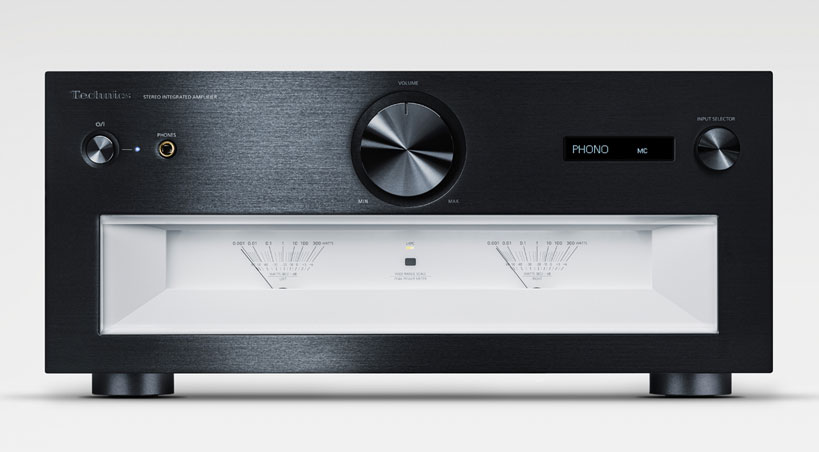
Technics SU-R1000 Integrated Amplifier – The first integrated amplifier of the Reference Class
Since Panasonic Corporation has given the Technics brand a new lease of life, it has already produced many fine solutions, but now they are preparing to define nothing less than a new reference, namely in the area of stereo integrated amplifiers. This task is the responsibility of the new Technics SU-R1000 Integrated Amplifier that has just been introduced.
It has been some time since the Japanese Panasonic Corporation decided to revive an almost legendary HiFi brand with Technics and set itself the goal of developing the finest solutions. Otherwise this venture would hardly have been crowned with success, but this is how remarkable products were presented time and again, some of which caused a sensation. This was evident in electronic components as well as loudspeaker systems, and of course in the brand’s turntables, which have always enjoyed cult status.
It all started with the finest amplifier solutions, such as the Technics SE-R1 Stereo Power Amplifier introduced in 2014, which, according to the manufacturer, is the first stereo power amplifier of the Technics Reference Class R1 Series, which is considered as a kind of milestone in the development of digital amplifiers technology as a whole, and who had the ideal play partner at his side in the Technics SU-R1 Network Audio Control Player.
This digital amplifier featured many new and original digital technologies, as the manufacturer states, such as Load Adaptive Phase Calibration, LAPC for short, or Jitter Elimination and Noise-Shaping-Optimization, the so-called JENO-Engine, all of them are essential for the Technics SE-R1 to come up with a particularly precise sound image and room-filling sound ambience and thus was and is an immense success. Panasonic Corporation is convinced that the sound quality is now to be raised to a completely new level with the market launch of the new Technics SU-R1000 Integrated Amplifier.
The new amplifier Technics SU-R1000 Integrated Amplifier is not only the first of its kind in the Reference Class at Technics, it should set new standards overall, because they have relied on many years of research and development work, digital amplifiers per se to improve. The product description of the Technics SU-R1000 Integrated Amplifier contains a multitude of exclusive technologies, such as the well-known JENO-Engine and LAPC, but also new ones such as ADCT, which should also help to achieve the ambitious goal of the developer, as well as a further developed Power supply, outstanding components and a sophisticated structure. There are also flexible connection options including a phono preamp that uses DSP which is known as Intelligent Phono EQ.




Technics is convinced that analog high-end amplifiers, due to their long history and thus proven technologies, are more or less exhausted when it comes to the potential for improvement in sound quality. Digital amplifiers, on the other hand, offer a comparatively large field of activity for developers in this regard, because immense progress has been made in recent years especially with regard to increasingly precise signal processing on the digital level. We have already reached a level that is no longer feasible with analog systems, and music is now largely consumed in digital form, be it CD or streaming, so that it seems more sensible to use digital amplifiers. Analog sources, such as records, can be integrated via high-quality converters anyway, which also guarantee high-precision signal processing.
The technologies that can now be found in the new Technics SU-R1000 Integrated Amplifier, of course, go back to 2014 and the market launch of the Technics SE-R1 Stereo Power Amplifier mentioned above, nevertheless the years since then have been worked on at full speed, to further optimize digital amplifiers, and all these technical innovations developed in the course of research can now be found in the new Technics SU-R1000 Integrated Amplifier.
The new Technics SU-R1000 Integrated Amplifier also relies on the Technics Jeno-Engine, which, as already mentioned, stands for Jitter Elimination and Noise-Shaping-Optimization. The aim here is to preventJitter as one of the main causes of distortion in digital systems, which is caused by incorrect timing of the master clock used in the digital-to-analog conversion.
The circuit developed by Technics uses a clock generator for Noise Shaping to reduce Jitter in the lower frequency range and a high-precision sampling converter in the upper frequency range. A special PWM converter assembly is to prevent errors when converting to PWM – Pulse Width Modulation. Through an optimized speed of the Noise Shaping, an optimized degree of the requantization number and an optimized PWM gradation, a signal conversion should be achieved without impairing the dynamic range, especially high-resolution signals, so that ultimately a natural reproduction is guaranteed even with the finest nuances.
Technics LAPC or Load Adaptive Phase Calibration can also be found in the new Technics SU-R1000 Integrated Amplifier. With this, the manufacturer describes a function in which the impedance characteristics of the low-pass filter on the output side do not influence the frequency representation, as is usual with conventional digital amplifiers. Technics LAPC measures the phases and impedance properties of the connected loudspeaker systems. Based on this, a DSP-based optimization algorithm is used to achieve an ideal impulse response. In contrast to conventional concepts, this achieves a frequency response that is flat in both amplitude and phase for sound reproduction with particularly precise spatiality, according to the manufacturer’s promise.
The latest technology that Panasonic Corporation engineers have devised for the Technics SU-R1000 Integrated Amplifier is called ADCT, or Active Distortion Canceling Technology. This extracts and eliminates precise distortions in the power output stage which, according to the manufacturer, can be caused by voltage drops and electromotive effects in the loudspeaker systems. Determine here any deviations between the loudspeaker output and the Jeno output and correct the digital output signal if necessary. Regardless of the loudspeaker type, excellent sound performance is offered, so that the advantages of a digital amplifier, such as particularly low noise, what the manufacturer calls a sharp sound image and an expansive sound atmosphere with a powerful drive at the same time, come into their own.
The basis of every excellent amplifier is an excellent power supply, and this of course also applies to the new Technics SU-R1000 Integrated Amplifier. A high-performance switched-mode power supply is used here, which is referred to as an Advanced Speed Silent Power Supply. Compared to conventional switched-mode power supply systems, there is no modulation noise that could affect the sound quality, and it offers a power supply with a fast response time and a high power level.
And that’s not all, the Technics SU-R1000 Integrated Amplifier uses four independent power supply units. Even if this new amplifier is a stereo integrated amplifier, the internal structure ultimately relies on a preamplifier and an output stage in a mixture of analog and digital circuits. So the decision was made to use said four power supply units independently of one another, one each for the analog and digital area of the preamp, and one each for the left and right channels of the power amplifier, because these require a particularly high output. Any disturbance between the circuit blocks should be prevented in the approach.
It should also be mentioned that in the output stage of the new Technics SU-R1000 Integrated Amplifier GaN-FET drivers are used (Gallium nitride), which, according to Panasonic Corporation, have a very low resistance and extremely short switching times. This is also an essential point to enable a dynamic, exact sound image.
How meticulously the developers went to work when designing the new Technics SU-R1000 Integrated Amplifier can already be seen in what has been described so far, plus a clock that is fed by a battery. The more precise the clock of a digital amplifier is, the higher the sound quality that can be achieved with it. Therefore, any noise should also be suppressed here by supplying it with a battery.
It goes without saying that the new Technics SU-R1000 Integrated Amplifier has a large number of inputs, as well as the fact that digital sources (two coaxial S/PDIF, two optical S/PDIF, two USB) can be connected in addition to analog. First and foremost, USB signals are processed in linear PCM with up to 32 bits and 384 kHz and DSD with up to DSD 22.4 MHz. Content coded in MQA can also be played. Of course, it is a USB 2.0 port that relies on asynchronous data transfer.
The analog interfaces have both asymmetrical and symmetrical inputs (cinch or XLR), and the Technics SU-R1000 Integrated Amplifier has a record out and record in, a pre out and a main in.
And then there is an integrated phono preamp, which stands out simply because both unbalanced and balanced inputs are available here. Of course it is equally suitable for MM as well as MC cartridge systems, but the real specialty is that it is supposed to be an “intelligent” phono preamp.
The basis for this is DSP-based signal processing, which gives the Intelligent Phono EQ of the Technics SU-R1000 Integrated Amplifier special capabilities.
Three functions are available here, which can be switched on or off as required.
It starts with Accurate EQ Curve. A hybrid A/D-converter is used here, in which a low-pass filter (LPF) performs analog processing, and high frequencies are increased with high accuracy after the analog-digital conversion. This is intended to prevent any bit losses during digital filter processing and to achieve a high signal-to-noise ratio.
Response Optimiser is the third option, and this is also measured, but the frequency response. This is done using a Time Stretched Pulse Signal, or TSP for short. The corrections based on this should lead to an almost perfect equalization curve.
To conclude the look at the back, the new Technics SU-R1000 Integrated Amplifier naturally has trigger connections to ensure control with other components, an additional USB port is provided for updates, and there are eight massive screw terminals for connecting the speakers available. This means that an A/B operation is just as possible as Bi-wiring.
The front of the new Technics SU-R1000 Integrated Amplifier looks very familiar, here the developers rely on the well-proven design language, which is a successful mixture of a little retro touch and technically sober appearance. In the center of the top there is a rotary encoder for the volume, to the left of it the standby button, a status LED and a 6.3 mm jack for headphones. To the right of the rotary encoder, an OLED display provides information about the most important parameters and the active input, which can be selected with another smaller rotary encoder on the far right. Below that, almost the entire width of the front is taken up by classic VU meters.
In view of the technical refinements, the performance information degenerates into banal key data: the Technics SU-R1000 Integrated Amplifier develops two times 150 watts on speaker systems with an impedance of 8 ohms, it is a proud 300 watts per channel when the speakers have an impedance of only 4 ohms.
The almost solid metal housing with its extremely elegant brushed aluminum front in black or silver sits enthroned on solid feet. It measures 430 x 191 x 459 mm. This brings the new Technics SU-R1000 Integrated Amplifier to around 22 kg.
All those who are enthusiastic about the new Technics SU-R1000 Integrated Amplifier and thus the first stereo integrated amplifier of the Technics Reference Series will have to be patient for it, but not for too long. This should be available in specialist shops as early as November 2020. You have to estimate a recommended retail price of € 7,499 for this.
Getting to the point
The new amplifier Technics SU-R1000 Integrated Amplifier is not only the first of its kind in the Reference Class at Technics, it should set new standards overall, because they have relied on many years of research and development work, digital amplifiers per se to improve. The product description of the Technics SU-R1000 Integrated Amplifier includes a large number of exclusive technologies, such as the well-known JENO-Engine and LAPC, but also new ones such as ADCT, which should also help to achieve the ambitious goal of the developer, as well as a further developed one Power supply, outstanding components and a sophisticated structure. There are also flexible connection options including a phono preamp that uses DSP and is known as Intelligent Phono EQ.
| Manufacturer: | Panasonic Corporation |
| Distribution: | Panasonic Deutschland – Eine Division der Panasonic Marketing Europe GmbH |
| Price: | € 7.499,- |






